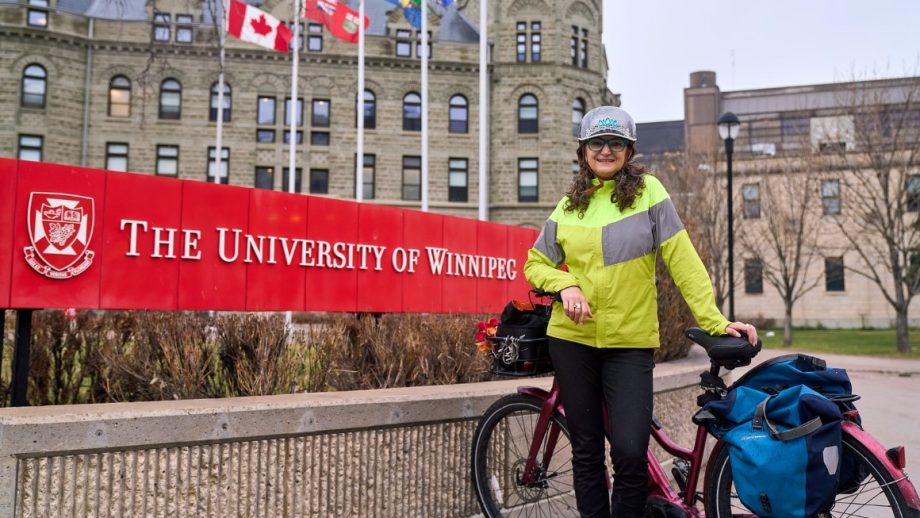Premier Gary Doer today announced an investment of $10 million in the University of Winnipeg’s capital program that will make possible the construction of a new science complex at the university which will also provide a home for the recently-announced Richardson College for the Environment. The premier also committed to a matching fundraising campaign over the next three years with the University of Winnipeg to provide up to $15 million in additional support. For every two dollars raised by the university, the province will contribute a dollar.
“Today’s announcement supports the construction of one of the most environmentally-sustainable buildings in Canada,” said Doer. “It will be a significant contribution to the ongoing renewal of downtown Winnipeg and will complement the energy-efficient Hydro building currently emerging before our eyes. The building crane remains in downtown Winnipeg.”
The University of Winnipeg’s science complex and the Richardson College for the Environment, to be located on Portage Avenue between Langside and Furby streets, will provide a new state-of-the-art laboratory, classroom and office space for the university’s growing student population and expanding pool of researchers in the sciences and environmental studies.
Built to meet the gold standard of the Leadership in Energy and Environmental Design (LEED) green building rating system, this facility will add five to eight per cent of urgently-needed space at the university and will be linked to the main campus via a green corridor.
“We are very thankful for this investment in the future of the University of Winnipeg by the province of Manitoba,” said university president and vice-chancellor Dr. Lloyd Axworthy. “This generous support will help to make the university’s new science complex and the Richardson College for the Environment a reality. It will become a centre for cutting-edge innovation and research in emerging areas of science and environmental studies. And it will serve as a catalyst for substantial urban renewal in inner-city Winnipeg.”
The science complex will initially house the biology, chemistry and environmental studies departments along with the Richardson College for the Environment. The complex and the college will not only significantly enhance the science and research capacity at the University of Winnipeg, but also for the province of Manitoba as whole.
With this facility, the University of Winnipeg will add to the strengths already present at the province’s other universities and research institutes such as Bio-Med City, the Public Health Agency of Canada and International Institute for Sustainable Development.
With construction slated to begin in the summer of 2007, the complex will feature a central atrium that will serve as the lungs for the complex and a green roof planted with native prairie vegetation. The building will also include the most innovative technology for heating, air conditioning, lighting and renewable construction materials. This investment, combined with the University of Winnipeg’s new sustainability policy, further enhances Manitoba’s reputation as a leader in environmental sustainability and green building technology and innovation.
The new science complex will also become an integral part of the West End neighbourhood serving as a source of significant economic and community renewal. Working in partnership with all levels of government and community organizations, the University of Winnipeg will develop new business and employment opportunities, increased campus and community amenities, new mixed-housing options and public education programs for the local area.
The complex, along with the Richardson College for the Environment, will also provide opportunities for Aboriginal and inner-city children. For example, innovative science programming already underway at the university such as Eco-Kids explores the relationship between culture, science and the environment, and links the Aboriginal community’s traditional teachings with science curriculum. A model-school component will provide hands-on opportunities and demonstration labs for high schools, as well as inner-city and Aboriginal students to learn science, relating indigenous values to traditional scientific and environmental issues.
The estimated cost of the project is $30 million including land, building, fixtures and lab equipment. An initial investment of $3.5 million was made by the Richardson Family, Firm and Foundation on Sept. 12 to establish the Richardson College for the Environment and to develop an urban environmental garden. The University of Winnipeg will continue to develop other public, private and voluntary sector partnerships to support the remainder of the funding requirements. Provincial funding for today’s announcement has been allocated from federal C-48 resources.
MEDIA CONTACT
Ilana Simon, Communications Officer, The University of Winnipeg
P: 204.786.9930, C: 204.782.3279, E: i.simon@uwinnipeg.ca




